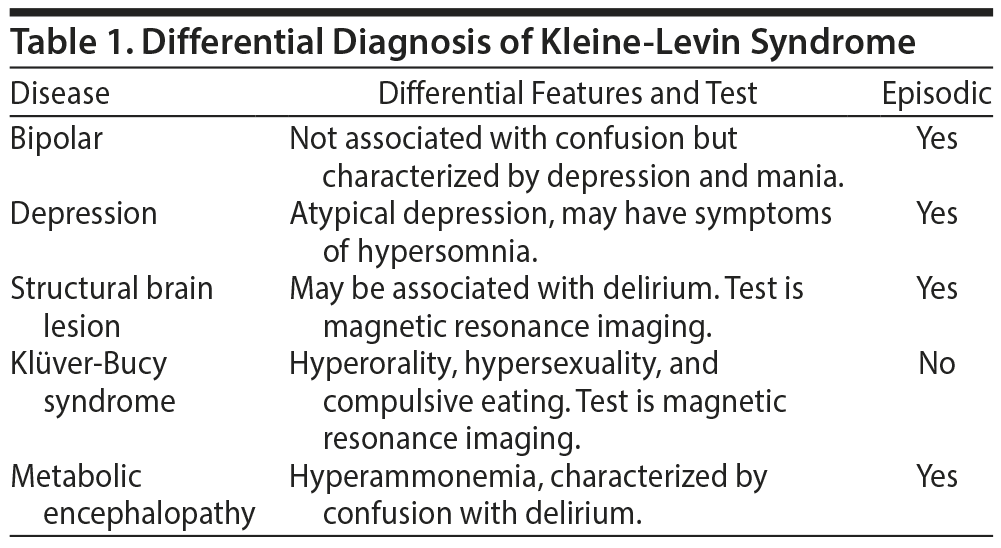Because this piece does not have an abstract, we have provided for your benefit the first 3 sentences of the full text.
To the Editor: Kleine-Levin syndrome (KLS) is a rare, chronic, relapsing sleep disorder usually affecting adolescent males and characterized by paroxysmal sleep attacks with prolonged hypersomnia and with variable associated waking symptoms of hyperphagia, hypersexuality, and peculiar altered mental status function. Sleep and waking function between attacks is normal, with highly variable disease-free intervals. The etiology of KLS is unknown, but it is believed to be a result of an underlying hypothalamic dysfunction or a postinfectious autoimmune disorder.
To the Editor: Kleine-Levin syndrome (KLS) is a rare, chronic, relapsing sleep disorder usually affecting adolescent males and characterized by paroxysmal sleep attacks with prolonged hypersomnia and with variable associated waking symptoms of hyperphagia, hypersexuality, and peculiar altered mental status function.1 Sleep and waking function between attacks is normal, with highly variable disease-free intervals. The etiology of KLS is unknown, but it is believed to be a result of an underlying hypothalamic dysfunction or a postinfectious autoimmune disorder.2 Neuroimaging, physical examination, and laboratory testing results are often unremarkable in these patients.2
The presentation, duration, course, and frequency of the disorder are quite variable among KLS patients. The variability of symptoms often contributes to the difficulty in diagnosing, treating, and ameliorating symptoms of the disorder. Treatment is primarily symptomatic, depending on the severity of the disorder and on any comorbidity affecting the patient.
KLS has an estimated prevalence of 1 to 5 cases per million people.3,4 It is more common among Ashkenazi Jews compared to the general population.3,4 This disorder is believed to be sporadic, although there have been some reports on familial cases, including monozygotic twins who both had KLS.3
Associated precipitating factors of KLS include infection, alcohol ingestion, sleep deprivation, severe stress, traveling, surgery, head trauma, illicit drug use, and physical overexertion.3
Case report. Ms A is a 44-year-old married white woman with a previous history of difficulty initiating sleep, which gradually disappeared but still left her with symptoms of excessive sleepiness associated with sudden “sleep attacks” lasting 2-3 days at a stretch and occurring 1 to 2 times a month. Although she had previously started a sleep log, she reported never completing it but stated that her normal sleep pattern between episodes had been about 5 hours nightly. The patient recalls having her first sleep attack 16 years previously in Saudi Arabia where she served voluntarily as a cook in the US Army for 4 months. She attributes major stress as a significant contributing factor to the onset of her periodic hypersomnia given the documented nerve gas exposure and chemical warfare she was exposed to during Desert Storm while in Saudi Arabia. (It is important to state here that Ms A, along with others who had similar toxic exposures in Saudi Arabia, are currently involved in ongoing research to determine the presence and extent of effects or complications from any of these exposures.) The episodes of hypersomnolence have negatively affected her life, as she has been unable to predict or control their recurrence or duration. As a consequence, she had to stop working as a teacher and now must leave the house accompanied by a family member. Preceding each episode, the patient reports feeling very hungry and having a strong desire for sex, and she has been told that her face looks like it is “melting off” because of its characteristic drooping eyes and facial dullness. She remarks that despite being very hungry before her sleep attacks, she is too tired to eat and has to be fed by her family members before falling into a deep sleep.
Recently, Ms A has had increased urinary frequency a day before each sleep episode, which now serves as a strong indication that her sleep attack is going to occur within 24-48 hours. She also described a sense of weakness lasting about 30-40 minutes before the onset of each episode.
During these prolonged sleep episodes, the patient is unresponsive to any attempts to awaken her and she becomes angry with family members because of their attempts to wake her. She denies the loss of bladder control during these episodes and often wakes feeling refreshed, but with a migraine. Although she had no history of migraine prior to the onset of KLS, she developed migraines after the onset of KLS. Furthermore, she reports that although the recent use of modafinil 200 mg had reduced the duration of her sleep attacks to 1 day, she now has migraines that start at the onset of her episodes instead of occurring at the end of her episodes, as was the case prior to modafinil therapy. Nonetheless, Ms A had been able to manage her migraine with over-the-counter analgesics. The patient reported amnesia about events before and during her sleep attacks. During the most recent occurrence, she had insisted on seeing her father, whom she claimed she had not seen in weeks; however, she had been with her father the day before the incident. Her family members have told her that she talks about things that never happened, pointing toward the possibility of some derealization during her episodes.
There is no family history of KLS or of any other sleep disorder. The patient’s past medical history includes restless legs syndrome (RLS), fibromyalgia, and depression for which she takes gabapentin 900 mg, venlafaxine 75 mg, and fluoxetine 40 mg daily, respectively. Although she reports more improvement in the past with rotigotine for RLS than with gabapentin, which provides only minor relief compared with rotigotine, rotigotine is not covered by her insurance, and she is left with no choice other than to continue with the use of gabapentin for her RLS. Her psychiatrist recently weaned her off of venlafaxine in an attempt to reduce the number of prescriptions she is taking. Since then, her depression has remained stable but persistent. The patient attributed her persistent depression to the repeated sleep attacks, which have failed to resolve, and the negative impact on her life and functioning. She had undergone magnetic resonance imaging and computed tomography brain scans, which appeared normal. A polysomnogram (PSG) performed in 2012 supported the diagnosis of RLS, and another in 2016 supported the diagnosis of hypersomnia. The PSG revealed an increased periodic limb movement index of 20/h and an unremarkable apnea-hypopnea index of 1.4/h. Multiple sleep latency testing5 showed clinically significant mean sleep latency of 6 minutes but with no REM sleep, providing objective documentation of a non-narcoleptic form of hypersomnia. The patient also had an elevated Epworth Sleepiness Scale (ESS)6 score of 14. A continuous video electroencephalography (cv-EEG) done on 1 occasion of her sleep spells indicated a short latency to sleep without epileptiform activity interictally. Also, drug testing done on the same occasion was negative. Although the patient was initially placed on ropinirole for RLS, this medication was discontinued due to side effects of leg pain, and as stated earlier, the patient’s RLS is currently managed with gabapentin. There has been no adverse effect of treatment of her RLS on her KLS. Also stated in the patient’s past medical history are low vitamin D, potassium, and magnesium.
Ms A recounted a life filled with stress beginning with voluntarily enlisting in the Army and having missile and nerve gas exposures, although no physical impact was sustained, followed by the birth of her child after a pregnancy that had many complications due to being assaulted by her ex-husband, whom she later divorced. The patient recalled being told by her doctors during her deployment in the Army that the onset of her sleep attacks was due to panic attacks and physical stress. As a result, she attributes stress as a significant precipitating factor to the development of KLS.
Although the duration of the patient’s sleep episodes had decreased to 24 hours from 2 to 3 days because of modafinil therapy, Ms A continues to struggle with a severe migraine at the onset of a sleep attack since starting modafinil. Recently, she went into a sleep attack that lasted 4 days instead of the usual 24 hours, stating the reason was her failure to take modafinil for 2 consecutive days prior to the episode.
Studies have shown that the median age at onset for KLS is 16 years, with approximately 80% of patients being in the second decade of life and presenting with more frequent episodes but shorter duration. On the other hand, patients with late onset (> 35 years) usually present with typical symptoms but longer episodes.3 Ms A is in the 4th decade of life and presents with shorter duration and more frequent episodes. Although stress is believed to play a role in precipitating KLS, there has been no report on the severity of stress or kind of stress in patients prior to the onset of KLS. Consequently, the actual precipitating factor to the onset of KLS in this patient remains unknown.
According to the International Classification of Sleep Disorders (ICSD-3),1 the diagnosis of KLS should include all of the following: hypersomnolence and related symptoms cannot be explained by another sleep, medical, neurologic, or psychiatric disorder or the use of drugs or medications; normal alertness, behavior, cognitive function, and mood between episodes; recurrence of episodes at least once every 18 months usually more than once a year; at least 2 episodes of excessive sleepiness and sleep duration lasting for 2 days to 5 weeks; and finally, at least 1 of the following symptoms: cognitive dysfunction, altered perception, eating disorder, or disinhibited behavior such as hypersexuality that occurs during episodes.
It is essential to rule out other disorders that have some symptoms similar to KLS, such as bipolar disorder, atypical depression, seasonal affective disorder, structural brain lesion, Kl×¼ver-Bucy syndrome, and metabolic encephalopathy. The differential diagnosis of KLS is included in Table 1.
KLS is a rare condition with symptoms such as cognitive disturbances, hypersomnia, hyperphagia, and hypersexuality.3 Other, less common physical symptoms associated with this disorder include amnesia, photophobia, and headache and psychiatric symptoms such as aggressive behavior during episodes, depression, anxiety, hallucinations, and delusions. It is important to note that Ms A reported most of these symptoms of KLS.
The severity of symptoms can vary from duration of episodes to the frequency of sleep attacks per year. Mild cases of KLS may consist of 1 to 3 short episodes per year, compared to a moderate case, which may consist of monthly episodes lasting 3-7 days each. However, in severe cases, patients have been recorded to have 40 to 80 episodes in rapid succession or a prolonged episode lasting more than 4 weeks, as revealed in a study of 120 French patients with KLS.7 In such severe cases, there is a high likelihood of long-term alteration in mood and attention. Our patient had recurrent hypersomnia but it was atypical in that the age at onset was late and the symptoms were variable.
Hypersomnia, the primary characteristic of KLS, can occur during the day and night with intense dreaming and hypnagogic hallucinations in 50% of cases. However, sleep paralysis is uncommon, and patients return to the regular sleep pattern and vigilance between episodes.3 Cognitive impairment and derealization is another profound characteristic of this disorder, which Ms A experienced, as told by her family members. She often recalls none of the events, nor does she recall happenings in her immediate environment before her sleep episodes. It is important to note that the intense derealization often seen in KLS patients strongly correlates with the hypoperfusion of the right and left parietal-temporal junctions seen on neuroimaging of these patients.3 Migraines are present in some patients with KLS, for which the reason remains unclear as no signs of meningeal irritation or changes in cerebrospinal fluid have been reported in patients with this disorder.7
Although KLS diagnosis is clinically based, the results of PSG may vary depending on the stage of the disease. A PSG during an episode may show a shortened sleep onset latency and rapid eye movement (REM) latency. Multiple sleep latency testing done in a study4 involving 19 patients with KLS showed that about 40% of patients demonstrated a narcolepsy-like pattern, characterized by 2 or more sleep-onset REM periods. Neuroimaging results are often normal in patients with KLS.4 Although EEG readings in KLS are nonspecific, in about 70% of cases, a nonspecific diffuse slowing of 7 to 8 Hz in EEG activity has been observed.8 Even less frequent in the bilateral temporal or frontotemporal areas are low-frequency, high-amplitude waves (delta or theta).3
No specific effective therapy for KLS currently exists, though several medications are used. Our patient was prescribed lithium in the past with no benefit. Also, methylphenidate did not help much. Modafinil helped with reducing the duration of symptoms from 2 to 3 days to 1 day. Amantadine therapy has been reported to show a significant reduction in symptoms at the beginning of treatment at the onset of a sleep episode8,9; however, it loses its efficacy with repeated use. Furthermore, lithium and valproate are often recommended to prevent recurrence of symptoms.9 Other drugs that have been used in KLS include methylphenidate and amphetamine.4 These drugs increase awareness but do not improve cognitive complaints of the patients.9
The etiology of KLS remains unknown. The disease has a significant burden on the patients and families. Counseling should be encouraged, as this will increase the knowledge and future expectations about the disorder. Patients with KLS should be advised to take strategic short naps lasting about 10-20 minutes, at 2- to 4-hour intervals during the day.10 The patients should be discouraged from driving during their hypersomnolence phase. Finally, it is crucial to educate the patient’s family about the need for primary support for the patient and the importance of establishing a safe sleeping environment while monitoring the patient for any medical and psychiatric complications that may arise.
aDepartment of Neurology, Dallas VA North Texas Health Care System, Dallas, Texas
bDepartment of Psychiatry, UT Southwestern Medical Center, Dallas, Texas
cDepartment of Neurology and Neurotherapeutics, UT Southwestern Medical Center, Dallas, Texas
dMinnesota Regional Sleep Disorders Center, Minneapolis, Minnesota
eDepartment of Psychiatry, Hennepin County Medical Center, Minneapolis, Minnesota
fDepartment of Psychiatry, University of Minnesota Medical School, Minneapolis, Minnesota
Potential conflicts of interest: The authors state they have no conflict of interest or direct support relevant to this case report.
Funding/support: None.
Patient consent: Permission was received from the patient and a consent form signed by the patient to publish this case report.
Published online: January 10, 2019.
Prim Care Companion CNS Disord 2019;21(1):18l02319
To cite: Edaki O, Khawaja IS, Schenck CH. An atypical case of Kleine-Levin syndrome. Prim Care Companion CNS Disord. 2019;21(1):18l02319.
To share: https://doi.org/10.4088/PCC.18l02319
© Copyright 2019 Physicians Postgraduate Press, Inc.
References
1. Sateia MJ, ed. International Classification of Sleep Disorders. 3rd ed. Darien, Illinois: American Academy of Sleep Medicine; 2014.
2. de Araújo Lima TF, da Silva Behrens NSC, Lopes E, et al. Kleine-Levin Syndrome: a case report. Sleep Sci. 2014;7(2):122-125. PubMed CrossRef
3. Aran A, Mignot E, Arnulf I, eds. Kleine-Levin Syndrome (recurrent hypersomnia). UptoDate website. https://www.uptodate.com/contents/kleine-levin-syndrome-recurrent-hypersomnia. Accessed October 29, 2018.
4. Arnulf I. Kleine-Levin Syndrome. Sleep Med Clin. 2015;10(2):151-161. PubMed CrossRef
5. Richardson GS, Carskadon MA, Flagg W, et al. Excessive daytime sleepiness in man: multiple sleep latency measurement in narcoleptic and control subjects. Electroencephalogr Clin Neurophysiol. 1978;45(5):621-627. PubMed CrossRef
6. Johns MW. A new method for measuring daytime sleepiness: the Epworth Sleepiness Scale. Sleep. 1991;14(6):540-545. PubMed CrossRef
7. Lavault S, Golmard JL, Groos E, et al. Kleine-Levin syndrome in 120 patients: differential diagnosis and long episodes. Ann Neurol. 2015;77(3):529-540. PubMed CrossRef
8. Arnulf I, Zeitzer JM, File J, et al. Kleine-Levin syndrome: a systematic review of 186 cases in the literature. Brain. 2005;128(Pt 12):2763-2776. PubMed CrossRef
9. Arnulf I, Lin L, Gadoth N, et al. Kleine-Levin syndrome: a systematic study of 108 patients. Ann Neurol. 2008;63(4):482-493. PubMed CrossRef
10. Gupta R, Das S, Gujar K, et al. Clinical Practice Guidelines for Sleep Disorders. Indian J Psychiatry. 2017;59(suppl 1):S116-S138. PubMed CrossRef
Please sign in or purchase this PDF for $40.00.






